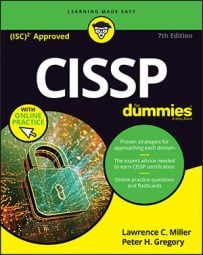-
Get a Good Night's Rest. The night before the exam isn't the time to do any last-minute cramming. Getting a good night's rest is essential.
-
Dress Comfortably. You should dress in attire that's comfortable and appropriate — remember, this is a three-hour exam for professional certification.
-
Eat a Good Meal. No matter how anxious you may be feeling, try to get something down before the exam. You have up to 3 hours to complete the CISSP exam — that's a long time to go on an empty stomach.
-
Bring Your Photo ID. You need to bring your driver's license, government-issued ID, or passport — these are the only forms of ID that are accepted.
-
Bring Snacks and Drinks. If your testing center allows it, consider bringing a small snack and a few drinks (water, juice, or soda — not beer!) to get you through the exam. Be sure you know the testing center’s rules and procedures for taking breaks and eating/drinking during the exam.
-
Bring Prescription or Over-the-Counter Medications. Again, check with your testing center and notify the test administrator if you’re taking any prescription medication that must be taken during the exam. Nothing can ruin your chances of succeeding on the CISSP exam like a medical emergency! Also, if you’re taking any over-the-counter meds, such as acetaminophen, nasal spray, or antacids to eliminate any annoying inconveniences such as headaches, heartburn, or a gastrointestinal malady, be sure to take them before you start the exam. A box of tissues might also be appropriate — if you have a cold or you feel like crying when you see the exam!
-
Leave Your Mobile Phone Behind. Turn off your mobile phones and anything else that goes beep or buzz.
-
Take Frequent Breaks. Three hours is a long time. Be sure to get up and walk around during the exam, if permitted. If not, at least stretch your legs, curl your toes, crack your knuckles, rest your eyes (but don’t fall asleep!), and roll your neck — or whatever you need to do (within reason) to keep the blood flowing throughout your body. Be sure to take a few short breaks during the exam.

